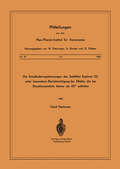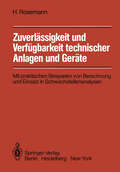- Table View
- List View
Werkstattsteuerung mit genetischen Algorithmen und simulativer Bewertung (IPA-IAO - Forschung und Praxis #220)
by Jörg SchulteFormleitlinien für die Flächenrückführung — Extraktion von Kanten und Radiusauslauflinien aus unstrukturierten 3D-Meßpunktmengen (IPA-IAO - Forschung und Praxis #276)
by Ralph P. KnorppErfassen und Verarbeiten komplexer Geometrie in Meßtechnik und Flächenrückführung (IPA-IAO - Forschung und Praxis #277)
by Thomas HallerReaktive Abscheidung von Metalloxiden auf Polycarbonat zur Erzeugung transparenter Verschleißschutzschichten (IPA-IAO - Forschung und Praxis #278)
by Patrick MarkschlägerAdaptive Personaleinsatzsteuerung in homogenen Arbeitsgruppen bei sequentieller Auftragsstruktur (IPA-IAO - Forschung und Praxis #279)
by Manfred HüserMeßeinrichtung zur direkten Unterscheidung von luftgetragenen biotischen und abiotischen Partikeln (IPA-IAO - Forschung und Praxis #280)
by Rüdiger KölblinPrüfverfahren zur Untersuchung der Partikelkontamination von Reinstgasversorgungskomponenten (IPA-IAO - Forschung und Praxis #282)
by Johann DornerRechnergestützte Gestaltungsvorgaben und Dialogbausteine für grafische Benutzungsschnittstellen (IPA-IAO - Forschung und Praxis #283)
by Rolf IlgEine Architektur verteilter Objekte zur Integration von Produktionsinformationssystemen (IPA-IAO - Forschung und Praxis #284)
by Thomas LinsenmaierSystem zur dezentralen Planung von Entwicklungsprojekten im Rapid Product Development (IPA-IAO - Forschung und Praxis #285)
by Kai WörnerAdhäsives Greifen von kleinen Teilen mittels niedrigviskoser Flüssigkeiten (IPA-IAO - Forschung und Praxis #286)
by Karl-Borries BarkEin generisches Optimierungsmodell für Zuordnungs- und Anpassungsaufgaben im Rahmen der Kapazitätsabstimmung (IPA-IAO - Forschung und Praxis #287)
by Gerd AupperleEinfluss der Produktgestalt auf den Energieaufwand beim Recycling mechanischer Bauteile und Baugruppen (IPA-IAO - Forschung und Praxis #288)
by Andreas FriedelEin objektorientiertes Verfahren zur Optimierung von Geschäftsprozessen unter Verwendung eines genetischen Algorithmus (IPA-IAO - Forschung und Praxis #289)
by Joachim BauskeMethode zur ergebnisorientierten Gestaltung von Entwicklungsprozessen (IPA-IAO - Forschung und Praxis #290)
by Patrick NoheIntegrierte Signalübertragung und E/A-Steuerungssystem für Montagezellen (IPA-IAO - Forschung und Praxis #291)
by Hyeck-Hee LeeEin Verfahren zur zielorientierten Auftragseinplanung für teilautonome Leistungseinheiten (IPA-IAO - Forschung und Praxis #292)
by Jürgen BischoffEin Messgerät zur Bestimmung der Strömungsgeschwindigkeit in Kurzen Rohren (Mitteilungen aus dem Max-Planck-Institut für Aeronomie #30)
by G. Rose H. U. WiddelDie Amplitudenregistrierungen des Satelliten Explorer 22, unter besonderer Berücksichtigung der Effekte, die bei Elevationswinkeln kleiner als 45° auftreten (Mitteilungen aus dem Max-Planck-Institut für Aeronomie #31)
by G. HartmannFlexible Shells: Theory and Applications
by E. L. Axelrad F. A. EmmerlingEuromech-Colloquium Nr. 165 The shell-theory development has changed its emphasis during the last two decades. Nonlinear problems have become its main motive. But the analysis was until recently predominantly devoted to shells designed for strength and stiffness. Nonlinearity is here relevant to buckling, to intensively vary able stress states. These are (with exception of some limit cases) covered by the quasi-shallow shell theory. The emphasis of the nonlinear analysis begins to shift further - to shells which are designed for and actually capable of large elastic displacements. These shells, used in industry for over a century, have been recently termedj1exible shells. The European Mechanics Colloquium 165. was concerned with the theory of elastic shells in connection with its applications to these shells. The Colloquium was intended to discuss: 1. The formulations of the nonlinear shell theory, different in the generality of kine matic hypothesis, and in the choice of dependent variables. 2. The specialization of the shell theory for the class of shells and the respective elastic stress states assuring flexibility. 3. Possibilities to deal with the complications of the buckling analysis of flexible shells, caused by the precritial perturbations of their shape and stress state. 4. Methods of solution appropriate for the nonlinear flexible-shell problems. 5. Applications of the theory. There were 71 participants the sessions were presided over (in that order) by E. Reissner, J. G. Simmonds, W. T. Koiter, R. C. Tennyson, F. A. Emmerling, E. Rarnm, E. L. Axelrad.
























